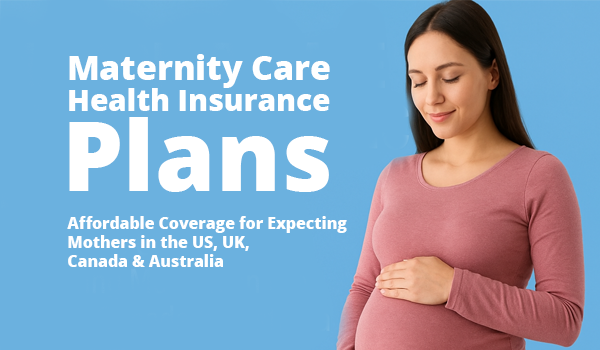Motherhood is a life-changing experience that brings joy, hope, and new beginnings. But it also brings financial responsibilities that can be overwhelming without the right protection. From prenatal visits and delivery to postnatal care and newborn health, the total cost of maternity can be significant—especially in Tier-One countries like the United States, United Kingdom, Canada, and Australia.
That’s where Maternity Care Health Insurance plays a crucial role. This specialized insurance ensures that expecting mothers receive top-quality medical attention without facing heavy hospital bills. It covers pregnancy-related expenses such as checkups, diagnostic tests, hospitalization, delivery, and newborn care.
In this comprehensive guide, you’ll discover the 7 best Maternity Care Health Insurance plans for affordable coverage in 2025—along with expert tips, benefits, and answers to common questions. Whether you’re a working woman, a growing family, or a first-time parent, these plans can help you plan for a healthy, stress-free pregnancy.

What Is Maternity Care Health Insurance?
Maternity Care Health Insurance is a specialized health insurance plan that helps cover the costs associated with pregnancy, childbirth, and postnatal care. This type of coverage ensures expecting mothers have access to essential medical services, including prenatal check-ups, ultrasounds, lab tests, and delivery costs.
In today’s healthcare environment, having maternity coverage is vital for families who want financial protection during pregnancy. Many plans also cover postnatal care for both mother and newborn, including vaccinations and medical complications, giving peace of mind during this important life stage.
Choosing the right Maternity Care Health Insurance plan can help manage expenses while ensuring quality care. Some plans offer cashless hospital services, reducing stress and simplifying the process for families.
When selecting a policy, it’s important to understand waiting periods, coverage limits, and any co-payments. Comparing different plans based on benefits and premiums can help families find the most suitable option for their needs.
Ultimately, Maternity Care Health Insurance is more than just financial protection—it is a support system that ensures a safe and healthy journey through pregnancy, delivery, and early motherhood.
Why You Need Maternity Care Health Insurance in Tier-One Markets
Even in developed healthcare systems, maternity care is costly. For instance:
- In the United States, childbirth without insurance can cost over $20,000.
- In the United Kingdom, private maternity care costs around £6,000–£10,000.
- In Canada, public healthcare covers most basic maternity services, but private maternity insurance helps with private rooms, extra diagnostics, and fertility care.
- In Australia, without maternity care health insurance, private hospital births can exceed AUD $10,000.
Having the best maternity care health insurance ensures that you don’t have to choose between comfort and cost. It allows mothers to focus on their health and their baby rather than on financial stress.
Table of Contents
Key Benefits of Maternity Care Health Insurance
- Comprehensive Financial Protection
Covers all major pregnancy-related medical expenses from conception to post-delivery. - Access to Quality Healthcare
Maternity care health insurance plans often include top-tier hospitals, OB-GYN specialists, and private maternity wards. - Newborn Baby Coverage
Most maternity plans cover the newborn for a defined period (usually 30–90 days after birth). - Prenatal and Postnatal Benefits
Expenses related to diagnostic tests, follow-ups, and medications are included. - Cashless Claims
Many maternity insurance providers offer cashless hospitalization in their network hospitals. - Tax Benefits
In many Tier-One markets, maternity insurance premiums can qualify for tax deductions or health credits. - Peace of Mind for Working Women
Women juggling career and family can rely on maternity care health insurance for financial stability and stress-free motherhood.
Features to Look for in a Good Maternity Care Health Insurance Plan
When comparing maternity care health insurance policies, focus on these important features:
- Coverage Duration: Includes prenatal to postnatal stages.
- Waiting Period: Most maternity insurance plans require a 9–24 month waiting period before benefits apply.
- Delivery Coverage: Both normal and C-section deliveries should be included.
- Newborn Health: Coverage for early child checkups and vaccinations.
- Hospital Network: Access to reputable hospitals and maternity clinics.
- Add-ons: Some policies include fertility treatment, lactation support, or postnatal physiotherapy.
A maternity care plan that offers a balance between affordability and wide coverage will always be the best investment for your growing family.

7 Best Maternity Care Health Insurance Plans for Affordable Coverage in 2025
Let’s explore the top-rated maternity care health insurance plans available in Tier-One markets — the USA, UK, Canada, and Australia.
1. UnitedHealthcare Maternity Care Health Insurance (United States)
Region: USA
Plan Type: Individual and employer-sponsored
Coverage Highlights:
- Comprehensive maternity health coverage for prenatal, delivery, and postpartum care.
- Access to UnitedHealthcare’s nationwide network of OB-GYNs.
- Includes newborn baby wellness visits and lactation consultation.
- Telemedicine and maternity support programs are available for working women.
Why It’s Among the Best Maternity Care Health Insurance Plans:
UnitedHealthcare offers personalized maternity support with digital pregnancy tracking tools and postpartum assistance programs. It’s an excellent choice for expectant mothers looking for both convenience and quality care.
2. Blue Cross Blue Shield Maternity Health Coverage (United States)
Region: USA
Plan Type: Group and individual
Coverage Highlights:
- Comprehensive coverage for pregnancy, labor, and postnatal care.
- Coverage for both normal and cesarean deliveries.
- Includes care for high-risk pregnancies.
- Provides newborn screening and wellness coverage.
Why It’s a Top Maternity Care Health Insurance Plan:
BCBS’s maternity coverage emphasizes preventive care and early pregnancy monitoring. The company’s telehealth maternity programs and round-the-clock support make it ideal for working professionals.

3. Bupa Family Maternity Plan (United Kingdom & Australia)
Region: UK and Australia
Plan Type: Private maternity add-on
Coverage Highlights:
- Covers prenatal checkups, labor, and delivery in private hospitals.
- 24-hour maternity helpline for guidance.
- Includes newborn care for the first 28 days.
- Access to midwives and private maternity rooms.
Why It’s One of the Best Maternity Care Health Insurance Options:
Bupa is trusted across both the UK and Australia for its exceptional maternal care services. Its maternity plan offers personalized support for every stage of pregnancy.
4. AXA PPP Healthcare Maternity Coverage (United Kingdom)
Region: UK
Plan Type: Private maternity health insurance
Coverage Highlights:
- Consultant-led maternity care.
- Covers both normal and cesarean births.
- Access to private maternity suites and postpartum care.
- Option to include fertility and pre-conception benefits.
Why It’s a Top-Rated Maternity Care Health Insurance Plan:
AXA PPP offers flexibility and privacy, ensuring mothers receive premium medical care in the hospital of their choice. The plan is particularly popular among professionals seeking a smooth, private childbirth experience.
5. Manulife Maternity Health Insurance (Canada)
Region: Canada
Plan Type: Supplemental maternity coverage
Coverage Highlights:
- Includes extended maternity care not covered by public health insurance.
- Covers private hospital rooms, prenatal supplements, and diagnostic tests.
- Access to physiotherapy, nutrition, and postpartum counseling.
- Newborn care and pediatric coverage available.
Why It’s One of Canada’s Best Maternity Care Health Insurance Plans:
Manulife’s maternity coverage fills the gaps left by public insurance. It’s ideal for families seeking comfort, privacy, and full maternity care benefits.

6. Medibank Gold Hospital with Maternity (Australia)
Region: Australia
Plan Type: Private health insurance
Coverage Highlights:
- Covers hospital stays, delivery costs, and antenatal classes.
- Includes both natural and cesarean delivery.
- Access to Medibank’s extensive hospital network.
- Provides newborn baby coverage for the first 60 days.
Why It’s Among the Best Maternity Care Health Insurance Plans in Australia:
Medibank Gold offers an outstanding balance between affordability and premium maternity benefits, making it a popular choice among working families.
7. Cigna Global Maternity Care Health Insurance (Worldwide)
Region: Global (Tier-One coverage available)
Plan Type: International health plan
Coverage Highlights:
- Worldwide maternity coverage for expatriates and global families.
- Covers prenatal care, delivery, and postnatal recovery.
- Includes newborn baby care and pregnancy complications.
- 24/7 multilingual support with global claim settlement.
Why It’s the Best Maternity Care Health Insurance for Expats:
Cigna’s Global Maternity Care Plan is ideal for families who move between Tier-One countries. It provides flexibility, comprehensive benefits, and international hospital access.
Comparison of the Top 7 Maternity Care Health Insurance Plans
| Provider | Region | Special Feature | Waiting Period | Newborn Coverage |
|---|---|---|---|---|
| UnitedHealthcare | USA | Digital pregnancy tools | None for group plans | Yes |
| BCBS | USA | High-risk pregnancy coverage | None for group plans | Yes |
| Bupa | UK/AUS | Private hospital access | 12–24 months | 28 days |
| AXA PPP | UK | Private maternity suite options | 9–12 months | Yes |
| Manulife | Canada | Extended coverage beyond public care | Province-specific | Yes |
| Medibank | Australia | Gold hospital tier | 12 months | 60 days |
| Cigna Global | Global | Worldwide maternity coverage | 12 months | 90 days |
Cost of Maternity Care Health Insurance in Tier-One Markets
- USA: $300–$800/month (individual plans)
- UK: £80–£250/month for private maternity add-ons
- Canada: CAD $150–$400/month for extended maternity coverage
- Australia: AUD $100–$250/month for private Gold-tier maternity policies
- Global (Cigna): $400–$900/month depending on region
While maternity insurance costs vary, the investment often saves thousands of dollars during delivery and hospital stay.
Best Affordable Plans for Working Women and Families (2025)
Why Maternity Care Health Insurance Matters More Than Ever
In 2025, the cost of childbirth and postnatal care continues to rise across Tier-One countries like the United States, Canada, the UK, and Australia. For working women and growing families, Maternity Care Health Insurance has become a vital financial safeguard. It ensures that pregnancy, delivery, and newborn care expenses are well-covered, reducing the economic strain that often comes with parenthood.
Whether you are a first-time parent or planning to expand your family, having the right Maternity Care Health Insurance plan can make all the difference. These plans offer coverage for prenatal checkups, delivery (including cesarean), postnatal care, and sometimes even the baby’s first few months of healthcare.
Let’s explore the best affordable maternity care health insurance plans for working women and families in 2025, along with key benefits and tips for choosing the perfect plan.
1. What Is Maternity Care Health Insurance?
Maternity Care Health Insurance is a type of health policy that provides financial coverage for pregnancy-related expenses. It covers the costs associated with prenatal checkups, delivery (normal or C-section), hospitalization, and postnatal care.
In some cases, the coverage also extends to:
- Newborn baby care for up to 90 days
- Vaccinations and pediatric checkups
- Complications during pregnancy or delivery
This type of health insurance ensures that both mother and baby receive quality care without financial stress.
2. Why Working Women Need Maternity Care Health Insurance
For working women, pregnancy often comes with challenges — managing career, health, and finances simultaneously. Having Maternity Care Health Insurance provides peace of mind and helps maintain financial stability during this phase.
Here’s why it’s particularly beneficial:
- Covers loss of income: Some plans offer maternity leave benefits.
- Ensures quality hospital care: Women can choose from top hospitals with maternity facilities.
- Reduces financial pressure: All key expenses related to childbirth are covered.
In 2025, with the increasing cost of private healthcare, Maternity Care Health Insurance is not just a luxury — it’s a necessity.
3. Key Benefits of Maternity Care Health Insurance Plans
When evaluating Maternity Care Health Insurance options, look for the following benefits:
a. Comprehensive Pregnancy Coverage
Covers prenatal consultations, ultrasounds, diagnostic tests, delivery (normal or cesarean), and postnatal care.
b. Newborn Protection
Some plans automatically extend coverage to the newborn baby, covering neonatal intensive care if needed.
c. Pre and Post-Hospitalization Expenses
Expenses like tests, medicines, and doctor consultations before and after delivery are included.
d. Cashless Hospitalization
Enjoy hassle-free hospitalization in network hospitals with direct billing.
e. Tax Benefits
Premiums paid toward Maternity Care Health Insurance are eligible for tax deductions under applicable laws (such as Section 80D in India or equivalent policies in other Tier-One countries).
4. Best Affordable Maternity Care Health Insurance Plans (2025)
After reviewing the top options across major Tier-One countries, here are the best maternity care health insurance plans that offer excellent coverage for working women and families.
1. UnitedHealthcare Maternity Coverage (USA)
Highlights:
- Covers prenatal, delivery, and postnatal care
- Access to a wide hospital network and specialist gynecologists
- Includes newborn wellness visits
Why it’s great: Comprehensive maternity and infant care benefits with flexible premium options.
2. Blue Cross Blue Shield Maternity Plan (USA & Canada)
Highlights:
- Offers maternity and newborn coverage in one package
- Includes lactation support and postpartum mental health coverage
- Cashless hospitalization at network hospitals
Why it’s great: Ideal for working women who need family-focused maternity support.
3. Aetna Global Health Maternity Coverage (UK, USA, Australia)
Highlights:
- Designed for international working professionals
- Includes maternity, neonatal, and pediatric care
- Covers prenatal classes and home nursing
Why it’s great: Perfect for expats and global families seeking international maternity coverage.
4. Bupa Family Maternity Insurance (UK & Australia)
Highlights:
- Covers pregnancy, childbirth, and newborn hospitalization
- Offers postnatal physiotherapy and counseling sessions
- Affordable premium packages for families
Why it’s great: Reliable coverage with excellent maternity care benefits and family-friendly services.
5. Cigna Global Maternity Plan (USA, UK, Canada)
Highlights:
- Includes prenatal, delivery, and postnatal expenses
- Coverage for complications during pregnancy and delivery
- Emergency evacuation for high-risk pregnancies
Why it’s great: Designed for international working women who travel frequently.
6. Medibank Private Maternity Coverage (Australia)
Highlights:
- Covers hospital and delivery costs
- Newborn care and parenting support programs
- 24/7 nurse helpline for expectant mothers
Why it’s great: Excellent support network for working mothers in Australia.
7. Sun Life Health Maternity Insurance (Canada)
Highlights:
- Coverage for maternity and early childcare
- Option to include the baby under the same plan immediately after birth
- Wellness and nutrition support included
Why it’s great: Affordable and comprehensive maternity coverage tailored for Canadian families.
5. How to Choose the Best Maternity Care Health Insurance Plan
When selecting a Maternity Care Health Insurance plan in 2025, consider the following factors:
- Waiting Period: Most plans have a waiting period (9 months to 2 years) before maternity benefits start. Plan.
- Coverage Limit: Check the maximum amount covered for delivery and hospital charges.
- Network Hospitals: Choose an insurer with a strong hospital network.
- Newborn Care: Ensure the baby’s initial medical needs are included.
- Premium vs. Benefits: Compare plans for affordability and coverage balance.
Choosing the right maternity care plan early ensures financial stability and peace of mind during pregnancy.
6. Why Early Enrollment Is Crucial
One of the most overlooked aspects of Maternity Care Health Insurance is the waiting period. Most insurers require you to hold the policy for a certain duration before you can claim maternity benefits.
That’s why it’s smart to enroll at least 1–2 years before planning a family. Early enrollment guarantees you can access full benefits when you actually need them, avoiding claim denials due to waiting period restrictions.
7. Financial and Emotional Security for Families
Beyond financial coverage, Maternity Care Health Insurance gives families emotional stability. Knowing that hospital bills, newborn checkups, and postnatal treatments are covered allows new parents to focus entirely on their baby’s well-being.
For working women, this coverage also provides the confidence to manage both professional responsibilities and motherhood without additional financial stress.
8. Tax Benefits and Long-Term Value
Most countries offer tax deductions for health insurance premiums. For example:
- In the U.S., you may deduct certain health-related expenses if you itemize deductions.
- In Canada, maternity-related health expenses are eligible under the Medical Expense Tax Credit.
- In Australia and the UK, you can save through private health rebates or relief programs.
Thus, Maternity Care Health Insurance not only protects your family but also helps reduce your taxable income.
Conclusion: Secure Your Future with the Right Maternity Care Health Insurance
In 2025, Maternity Care Health Insurance is more important than ever for working women and modern families. It ensures that pregnancy, delivery, and newborn care are financially manageable while providing top-quality medical support.
By choosing the right plan — whether it’s from UnitedHealthcare, Bupa, Aetna, or Cigna — families can enjoy peace of mind knowing they are protected during one of life’s most transformative moments.
Invest in your family’s health today and experience the true benefits of Maternity Care Health Insurance — affordable, reliable, and designed for the modern woman and her family.
How to Choose the Right Maternity Care Health Insurance Plan
- Start Early: Purchase your maternity plan at least 12–24 months before pregnancy to avoid waiting period restrictions.
- Compare Benefits: Analyze coverage for delivery, prenatal, and newborn services.
- Check Hospital Networks: Ensure your preferred maternity hospital is part of the insurer’s network.
- Review Exclusions: Fertility or elective procedures may not be covered.
- Look for Family Coverage Options: Choose plans that include newborn coverage.
- Focus on Claim Process: Go for insurers known for fast, cashless settlements.
- Evaluate Long-Term Value: Opt for maternity care insurance that also benefits future family needs.
Common Exclusions in Maternity Care Health Insurance
- Pre-existing pregnancies at policy purchase
- Elective or cosmetic C-sections
- IVF or fertility treatments (unless add-on)
- Surrogacy-related costs
- Extended hospital stays beyond the policy limit
- Non-prescription vitamins or supplements
Understanding exclusions helps you choose the most transparent and reliable maternity care health insurance provider.
Future of Maternity Care Health Insurance in 2025 and Beyond
Maternity care health insurance is evolving with new digital and wellness features:
- Telehealth and Virtual Maternity Consultations
- Mental Health Integration (postpartum depression coverage)
- Inclusive Coverage for LGBTQ+ Families
- Preventive Pregnancy Programs
- AI-based Pregnancy Risk Monitoring
These innovations make maternity care insurance more inclusive, affordable, and accessible worldwide.
Conclusion: Choose Maternity Care Health Insurance for a Safe, Stress-Free Journey
Pregnancy should be filled with happiness—not financial anxiety. With the best Maternity Care Health Insurance plans, you can secure complete medical protection for you and your baby. Whether you’re in the US, UK, Canada, or Australia, early investment in maternity care insurance ensures peace of mind and premium healthcare throughout your journey.
Each of the 7 best maternity care health insurance plans—from UnitedHealthcare to Cigna Global—offers unique advantages, from digital support tools to international coverage. Choose the one that fits your lifestyle, budget, and maternity needs, and step into parenthood with confidence.
Frequently Asked Questions (FAQ)
Q1. What is Maternity Care Health Insurance?
It’s a health plan that covers pregnancy, delivery, and newborn-related medical expenses for mothers and families.
Q2. Is Maternity Care Health Insurance included in regular health plans?
In some countries, yes. In others, maternity coverage is an optional rider or add-on benefit.
Q3. Can I get maternity insurance if I’m already pregnant?
Most insurers do not cover pre-existing pregnancies. Buy maternity insurance at least a year before planning.
Q4. Does Maternity Care Health Insurance cover C-section delivery?
Yes, most maternity care health insurance policies cover both normal and cesarean deliveries.
Q5. How long is the waiting period for maternity coverage?
Typically, between 9 months to 2 years, depending on the insurer.
Q6. Does maternity care insurance cover newborn health?
Yes, newborn coverage typically lasts 30–90 days post-delivery.
Q7. Which maternity care health insurance is best for working women?
UnitedHealthcare and Bupa are excellent for working mothers who need flexibility, telehealth, and cashless services.
Q8: What does Maternity Care Health Insurance cover?
It covers expenses related to pregnancy, childbirth, and postnatal care, including hospitalization and newborn medical costs.
Q9: Can I buy maternity insurance after getting pregnant?
Usually no. Most insurers have a waiting period, so it’s best to purchase Maternity Care Health Insurance in advance.
Q10: Are cesarean deliveries covered?
Yes, both normal and C-section deliveries are typically included in maternity insurance.
Q11: Do maternity plans include baby vaccinations?
Many comprehensive plans cover vaccinations and early child healthcare for up to 90 days post-delivery.
Q12: Is Maternity Care Health Insurance expensive?
Not necessarily. Several affordable plans in 2025 offer excellent coverage options for working women and families.




